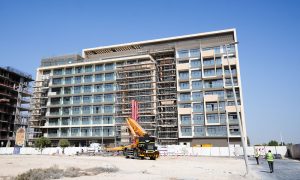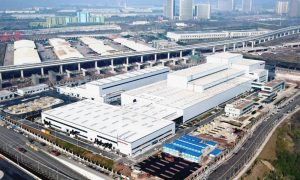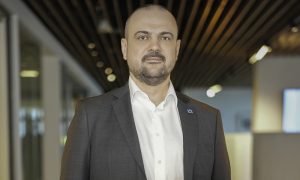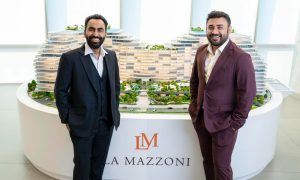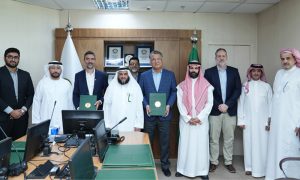2022 Future of Architecture Summit recap
Middle East Consultant’s 2022 Future of Architecture Summit defined forthcoming urban hallmarks and honoured the top architectural and design talents of tomorrow

Taking place at the Oberoi Hotel on 7 June 2022, the second iteration of Middle East Consultant’s Future of Architecture Summit (FOA) was created with two aims in mind: first, to ‘break the mould’ and attempt to define the future shape of the world not by looking at present trends but by asking leading architects and designers to do their best ‘blue sky’ thinking; and second, by running a brand-new awards event as part of the Summit – The Future Talent Awards, identifying top young architects and designers and honouring their thought-provoking compositions.
The day’s key topics embraced the Metaverse and its role as a new architectural universe; the pursuit of Wellness in an urban setting; and the increasingly crucial emphasis on re-purposing existing buildings and communities. Threaded throughout the day’s schedule, each of the six Future Talent Awards were presented so as to be aligned with actual Summit content.
The primary objective of generating and encouraging ‘blue sky thinking’ was made patently clear by the day’s first opening sessions: firstly, Prof. Dr. Anna Cornaro, Chair and Associate Professor of Architecture, American University in Dubai (AUD), reviewed the academic programmes which AUD has created in order to encourage fresh architectural initiatives and design concepts – which are often closely context-bound to real-world concerns such as sustainability, the role of the community and energy conservation. This very ‘grounded’ perspective was to be seen throughout the rich – and often emotionally stirring – award-winning projects presented by the students for the Future Talent Awards. Watch a live video of the address here.
This presentation was followed by a ‘fireside chat’ in which the event Moderator, Paul Godfrey – Head of Content, Middle East Consultant – sat down with Joe Tabet, Managing Director, JT+ Partners, and drew his thoughts on the impact and promise of the Metaverse. Key points to emerge here were Joe’s concern that far from being one homogenous platform, sharing a common bandwidth (in the same way, eg, as the internet), the Metaverse is in fact any number of separate and unrelated Metaverses, which at the moment any designer can invent and add to at will. His argument was that until this process is regulated in some shape or form, there cannot ever be value-sets (financial or otherwise) attached to the Metaverse, since it has no shared perception and ‘common ground’. Watch the discussion here.
But what about common experiences in terms of the world we live in right now? Amer Mneimneh, Vice President, Urbanism and Planning, AECOM ME, looked at how Dubai life could be made safer, healthier and more enjoyable by re-inventing and re-planning tracts of the urban landscape, so pedestrians can became a core priority (rather than being largely constrained by the road network), with their proximity to sports and leisure amenities drastically improved. All of which would help transition the emirate’s profile into a world-leading lifestyle and Wellness-focused city. No wonder, then, that his intriguing presentation was titled ‘Dubai City as a Gym’ – following on from an in-depth AECOM report of the same name, full of equally provocative and insightful urban comment. Watch the session here.
Meanwhile, Bainona Engineering Company has played an exceptional role in creating the structures and communities by which we define modern-day Abu Dhabi; and Naser Al Fakhouri looked at the way that materials, their forms and architectural possibilities have evolved across the years, enabling the current move towards nano-materials that are not only highly eco-compliant, but introduce all kinds of tensile horizons with reduced construction timings and – potentially – costs. Watch the presentation here.
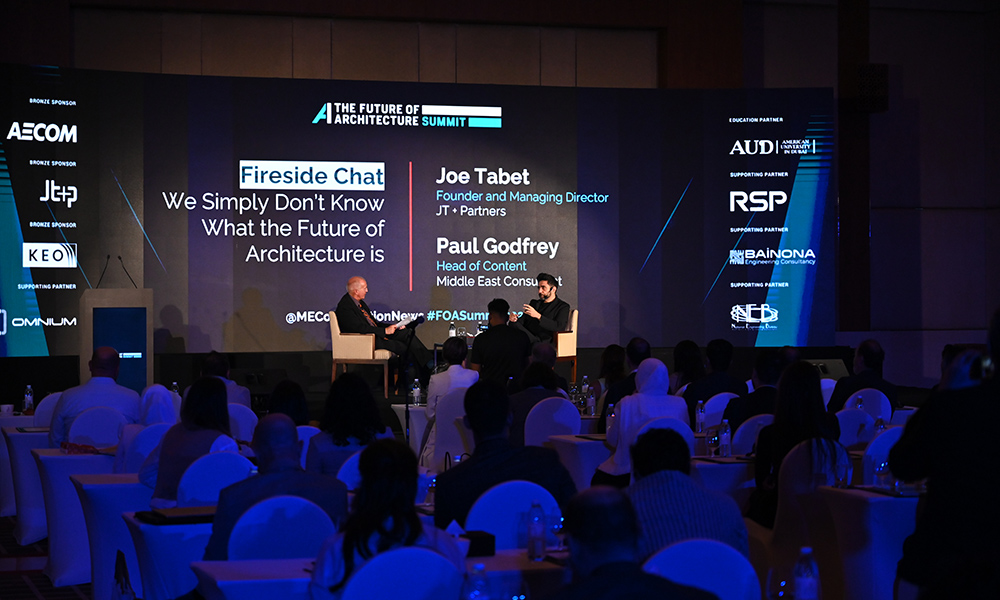
Don’t demolish – re-purpose!
Pragma’s Founder and Director, Ahmed Khadier, believes passionately that re-purposing existing structures is a far more practical, cost-efficient and less disruptive option than demolishing them and starting afresh. It also avoids releasing potentially mega-ton volumes of carbon into our atmospheres as the concrete is broken down. Ahmed looked at a range of extraordinary community projects in Sharjah, where the priority has been to re-invent community life by maximising the existing infrastructure and recognising people’s preferred lifestyle and habits. View his presentation here.
A similar attention to profiling human behaviour and creating architectural solutions where scale, practicality and proximity are priorities was seen in the exceptional presentation made by Kourosh Salehi, Design Director – MENA, LWK + Partners. He focused on one of the firm’s current pitch concepts, analysing the journey of millions of Hajj pilgrims around the city of Mecca, and creating highly innovative structures that on the one hand make the physical passage simpler and less arduous, while on the other are also constant reminders of the spiritual journey, with libraries and sacred precincts vividly interlocking. Watch Kourosh’s session here.
The summit then asked a simple question: how can we define the cities of the future? The answer was given by an expert panel session, titled ‘The Five Hallmarks of the Future City’. The concept of this session was cut through the somewhat vague, familiar statements about urban futures and to physically create a checklist that clearly defines what a city of the future will have that present ones do not. The panelists were:
- Ralph Steinhauer, Director, RSP
- Hassan Ali, Programme Leader, Department of Engineering, De Montford University, Dubai
- Martin Dufresne, Design Principal, U+A
- Hatham Mousa, Senior Project Designer, KEO
The panel’s Moderator was Prof. Mohannad Abu Suhaiban, Assistant Professor of Architecture, School of Architecture, Art& Design, American University in Dubai. Together, the panelists and moderator hammered out the five features by which we’ll recognise the all-new urban landscapes of the future. They are:
- Full sustainability
- Huge flexibility – built to accommodate future technologies (such as, eg, flying cars)
- Micro communities, but at giga-scale: the vast cities of the future will in fact be composed of thousands of highly liveable, urban ‘hubs’
- People-focused: people will be front and centre of the design blueprint – with a priority on pedestrian areas, sidewalks and boulevard design
- Appropriate materials – buildings will no longer simply use materials that look good and have high strength; tomorrow’s materials will also reduce stored heat and help environmental cooling and temperature regulation

The Future Talent Awards
In creating the Future Talent Awards, Middle East Consultant was hugely indebted to the role and support of the American University in Dubai (AUD) – with particular thanks to Prof. Dr. Anna Cornaro, Chair and Associate Professor of Architecture. It was decided that there would be six awards categories, and AUD brought together the last three years of graduate work for an expert panel of judges to assess. The judges were:
- Marija Milenkoska, Architect, Pragma
- Ralf Steinhauer, Director, RSP
- Drew Gilbert, Design Manager, OBM International
- Joe Tabet, Managing Director, JT + Partners
After considerable deliberation, the Awards were decided as follows. Please also see the Judges’ comments here, alongside the name of each winner.
Shape of the Future Award – Winner: Rhea Khoury
“We believe that this entrant has a remarkably mature and well-conceived vision of the future; far from being an ‘architect of tomorrow’, in many ways she is ready to assume this role today. We can clearly foresee that in the years to come, she will be pitching her concepts to some of the world’s leading corporate clients.”
The Sustainable Future Award – Winner: Nada Yusif Husein
“At a time when Sustainability has become an over-used watchword, it’s very tempting to take on too much and risk further resources in a futile way. This entrant understood that completely and didn’t try to ‘reinvent the wheel’. She has created a commercially-applicable plan of considerable maturity.”
Urban Infrastructure Award – Winner: Nadine Amaar
“Infrastructure is a topic that makes municipal authorities across the globe waste time and come unstuck. Here we find someone who has a clear understanding of an effective solution. While it can be further developed, this is a concept of strong professionalism and cleverly anticipates modern priorities and logistics.”
Cultural Identity Award – Winner: Joe Sassine Finianos
“Here we have someone of complete and masterful understanding of how to meet diverse – and so often conflicting – social, ethnic and cultural priorities. He has taken a controversial topic and made it the centre-piece of a much-needed urban renaissance.”

Commitment to Community Award – Winner: Dalia Qasem
“This entrant has a strong grasp of what comprises an effective commercial pitch, as well as a good understanding of who needs help and recognition in society – without unbalancing that society. This is a highly commendable project. When will see it actually developed?”
Tomorrow’s World Award (Overall winner) – Joe Sassine Finianos
“From the conceptual design point of view, his graphics and form language could be enhanced, but overall, his choice of project is a clear winner. It is relevant and well worked out from the narrative standpoint. 50 years of conflict, terror, pain and loss are showcased in an impressive experience trying to revive the area of the ‘big blast’ and help restore Beirut to its former glory.”
Watch the presentation of the awards here.
Next steps…
Like the Future of Architecture Summit itself, the Future Talent Awards will now become a regular annual event, and we look forward to growing their scale, outreach and impact in the years to come. Meanwhile, sincere thanks to our valued judging panel, Prof. Dr. Anna Cornaro, and Jocelyn Soriano, Administrative Assistant – Architecture, CRID.
Read more:
- Using digital twin technology in the metaverse to resolve complex infrastructure issues
- Gensler: The industry needs to move from reactive to frontline lead and drive climate targets
- Is repurposing structures the future of sustainable development?
